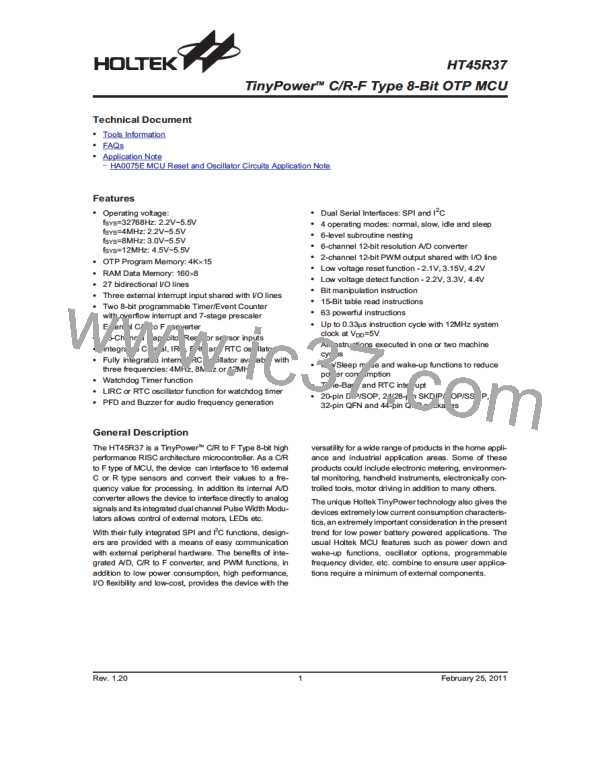HT45R37
Timer/Event Counters
The provision of timers form an important part of any
microcontroller, giving the designer a means of carrying
out time related functions. The device contains two 8-bit
count-up timers. As each timer has three different oper-
ating modes, they can be configured to operate as a
general timer, an external event counter or as a pulse
width measurement device. The provision of a prescaler
to the clock circuitry of the 8-bit Timer/Event Counter
also gives added range to this timer.
preload register will be in an unknown condition. Note
that if the Timer/Event Counter is switched off and data
is written to its preload registers, this data will be imme-
diately written into the actual timer registers. However, if
the Timer/Event Counter is enabled and counting, any
new data written into the preload data registers during
this period will remain in the preload registers and will
only be written into the timer registers the next time an
overflow occurs.
There are two types of registers related to the
Timer/Event Counters. The first are the registers that
contain the actual value of the Timer/Event Counter and
into which an initial value can be preloaded. Reading
from these registers retrieves the contents of the
Timer/Event Counter. The second type of associated
register is the Timer Control Register which defines the
timer options and determines how the Timer/Event
Counter is to be used. The Timer/Event Counters can
have the their clock configured to come from an internal
clock source. In addition, their clock source can also be
configured to come from an external timer pin.
Timer Control Registers - TMR0C, TMR1C
The flexible features of the Holtek microcontroller
Timer/Event Counters enable them to operate in three
different modes, the options of which are determined by
the contents of their respective control register.
It is the Timer Control Register together with its corre-
sponding timer registers that control the full operation of
the Timer/Event Counters. Before the timers can be
used, it is essential that the appropriate Timer Control
Register is fully programmed with the right data to en-
sure its correct operation, a process that is normally car-
ried out during program initialisation.
Configuring the Timer/Event Counter Input Clock
Source
To choose which of the three modes the timer is to oper-
ate in, either in the timer mode, the event counting mode
or the pulse width measurement mode, bits 7 and 6 of
the corresponding Timer Control Register, which are
known as the bit pair TnM1/TnM0, must be set to the re-
quired logic levels. The timer-on bit, which is bit 4 of the
Timer Control Register and known as TnON, depending
upon which timer is used, provides the basic on/off con-
trol of the respective timer. Setting the bit high allows the
counter to run, clearing the bit stops the counter. For tim-
ers that have prescalers, bits 0~2 of the Timer Control
Register determine the division ratio of the input clock
prescaler. The prescaler bit settings have no effect if an
external clock source is used. If the timer is in the event
count or pulse width measurement mode, the active
transition edge level type is selected by the logic level of
bit 3 of the Timer Control Register which is known as
TnE.
The internal timer¢s clock can originate from various
sources. The system clock source is used when the
Timer/Event Counter is in the timer mode or in the pulse
width measurement mode. This internal clock source is
fSYS which is also divided by a prescaler, the division ra-
tio of which is conditioned by the Timer Control Register,
TMRnC, bits TnPSC0~ TnPSC2.
An external clock source is used when the timer is in the
event counting mode, the clock source being provided
on an external timer pin TMR0 or TMR1 depending
upon which timer is used. Depending upon the condition
of the TnE bit, each high to low, or low to high transition
on the external timer pin will increment the counter by
one.
Timer Registers - TMR0, TMR1
The timer registers are special function registers located in
the Special Purpose Data Memory and is the place where
the actual timer value is stored. These registers are known
as TMR0 or TMR1. The value in the timer registers in-
creases by one each time an internal clock pulse is re-
ceived or an external transition occurs on the external
timer pin. The timer will count from the initial value loaded
by the preload register to the full count of FFH at which
point the timer overflows and an internal interrupt signal is
generated. The timer value will then be reset with the initial
preload register value and continue counting.
Configuring the Timer Mode
In this mode, the Timer/Event Counter can be utilised to
measure fixed time intervals, providing an internal inter-
rupt signal each time the Timer/Event Counter over-
flows. To operate in this mode, the Operating Mode
Select bit pair, TnM1/TnM0, in the Timer Control Regis-
ter must be set to the correct value as shown.
Bit7 Bit6
Control Register Operating Mode
Select Bits for the Timer Mode
1
0
In this mode the internal clock, fSYS , is used as the inter-
nal clock for the Timer/Event Counter. However, the
clock source, fSYS, for the 8-bit timer is further divided by
To achieve a maximum full range count of FFH for the
8-bit timer, the preload registers must first be cleared to
all zeros. It should be noted that after power-on, the
Rev. 1.20
21
February 25, 2011

 HOLTEK [ HOLTEK SEMICONDUCTOR INC ]
HOLTEK [ HOLTEK SEMICONDUCTOR INC ]